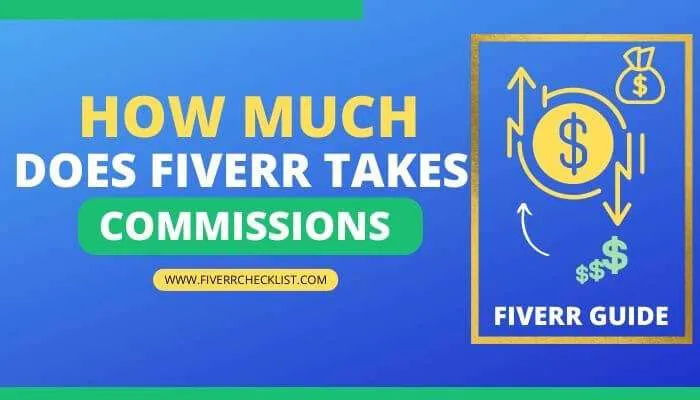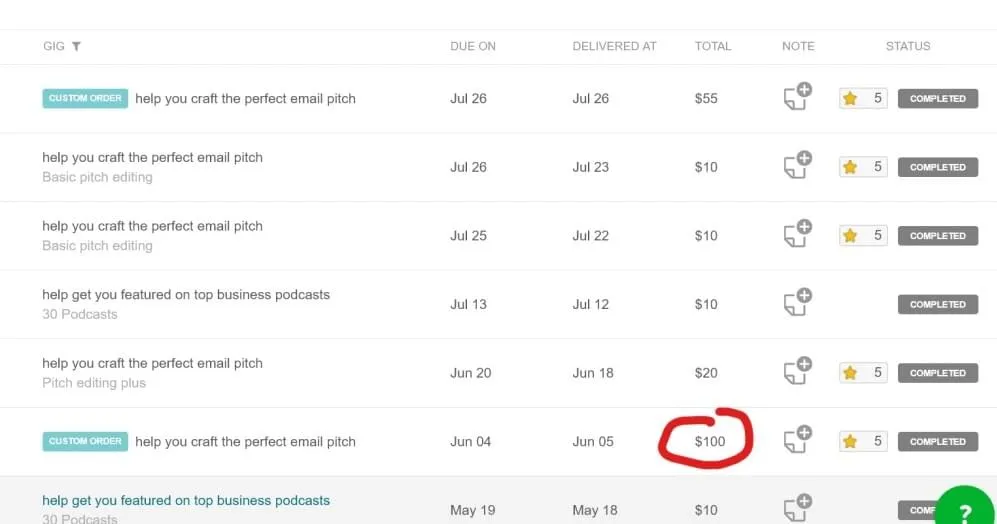Have you ever wondered how much money Fiverr keeps from your hard-earned gigs? If you're a seller on the platform, understanding the fee structure is crucial for maximizing your profits. In this post, we will dive into the percentages Fiverr retains from each order, shedding light on how it impacts your overall earnings. Let's break it down together!
Understanding Fiverr's Fee Structure

Fiverr has established itself as a leading freelancing platform, but like any service, it comes with its own set of fees. Understanding these fees is essential for both new and experienced sellers who want to ensure that they’re making the most out of their offerings.
So, how does Fiverr make money? Essentially, they charge a percentage fee on every order completed through the platform. The breakdown is pretty straightforward:
| Type of Seller | Fiverr's Fee Percentage |
|---|---|
| Basic Gig Sellers | 20% |
| Pro Sellers | 20% |
Regardless of whether you are a novice or a seasoned pro, Fiverr takes a hefty 20% cut from every completed order. This means that if you sell a gig for $100, you're only going to take home $80 after Fiverr's fee is deducted.
Additionally, Fiverr also charges buyers a service fee, which can sometimes influence how attractive your gig appears. This fee is separate and reflects the cost buyers incur when making a purchase.
It's worth noting that Fiverr’s fee structure has been designed to support the platform's ecosystem, ensuring quality service and improvements. So, while it might seem steep, this fee helps maintain a healthy marketplace.
In summary, knowing that Fiverr retains 20% of your earnings will better prepare you to set your prices accordingly. By factoring in these fees, you can ensure your efforts are rewarded and plan for more profitable sales in the future.
Also Read This: How to Get Pro Verified on Your Fiverr
3. Breakdown of Fiverr's Commission Rates

When you sign up to be a seller on Fiverr, it’s essential to understand how the platform’s commission structure works. Fiverr is quite transparent about its fee model, which can help you make informed decisions about your pricing.
Fiverr typically takes a *20% commission on every order. This means that for every $100 you earn from a client, Fiverr retains $20 as their service fee. Here’s a quick breakdown:
| Order Amount | Fiverr's Cut (20%) | Your Earnings |
|---|---|---|
| $100 | $20 | $80 |
| $50 | $10 | $40 |
| $200 | $40 | $160 |
It’s not just about the commission rate, as there might be additional fees related to currency conversion or deposit methods, depending on where you are located. That’s why it’s crucial to factor these fees into your pricing strategy so you don’t find yourself in a tight spot when it comes to your actual earnings.
Understanding this breakdown can help you set competitive but fair prices for your gigs that will also allow you to make a sustainable income.
Also Read This: Ever Wondered How to Outline an Image in Canva? Learn Here
4. How Fiverr's Fees Affect Sellers

Fiverr’s commission structure can significantly impact how sellers price their services and manage their earnings. Understanding these fees can be the difference between thriving and merely surviving on the platform.
First off, let’s address how the 20% commission affects your pricing strategy. Many sellers feel the pinch when they see that a fifth of their earnings goes to Fiverr, especially for lower-priced gigs. To counter this, sellers often increase their base prices. Here’s how this might look:
- If you want to end up with $100 from a gig, you’ll have to set the price at $125.
- The challenge becomes maintaining competitiveness while ensuring you cover the fees.
Additionally, if you're offering extra services or upsells, you’ll need to keep the commission in mind. These upsells can be a great way to enhance your earnings, but remember that Fiverr will still take 20% from these too. Every little bit counts when budgeting your earnings!
Moreover, some sellers express frustration over the timing of payments. Fiverr holds payments for a period after delivery, which means cash flow can sometimes be a challenge for sellers relying on prompt payments to manage their finances. This might push sellers to rethink their gig frequency or other income sources outside Fiverr.
In summary, being aware of Fiverr’s fees allows sellers to structure their services better, ensuring they can maintain a profitable and sustainable business while navigating the competitive landscape of freelancing.
Also Read This: How to Post a Service on Fiverr: A Step-by-Step Guide
5. Case Studies: Examples of Earnings
Let's dive into some real-life examples to get a clearer picture of how Fiverr's fee structure affects earnings. Knowing how much freelancers can bring home after Fiverr takes its share can provide valuable insight for both new and seasoned freelancers.
Consider the following case studies:
- Graphic Designer: Jane is a graphic designer who offers logo design services on Fiverr. Her basic gig is priced at $100.
- Content Writer: Mark specializes in blog writing and charges $50 per article on Fiverr.
- Web Developer: Sarah provides website development services at a premium rate of $500 for a standard project.
Now, let’s break down their earnings considering Fiverr's service fee of 20%:
| Freelancer | Gig Price | Fiverr's Cut (20%) | Earnings After Fee |
|---|---|---|---|
| Jane (Graphic Designer) | $100 | $20 | $80 |
| Mark (Content Writer) | $50 | $10 | $40 |
| Sarah (Web Developer) | $500 | $100 | $400 |
These examples showcase that while Fiverr does take a notable portion of earnings, many freelancers still manage to earn well, especially when they build a strong reputation and clientele on the platform.
Also Read This: Top 10 online data entry jobs sites
6. Comparison with Other Freelance Platforms
When discussing Fiverr’s earnings and fees, it’s essential to compare it with other freelance platforms. Each platform has its unique features, fee structures, and earning potentials that can affect how much freelancers pocket. Let’s look at how Fiverr stacks up against some popular alternatives:
- Upwork: Upwork has a tiered fee structure where freelancers pay between 5% to 20% based on their earnings with a specific client. The more you earn from that client, the less you pay in fees. This can ultimately lead to lower fees for long-term projects compared to Fiverr.
- Freelancer: Freelancer.com charges fees of around 10% or $5 minimum, whichever is greater. This can be more favorable for small gigs, but it also depends on project complexity and client relationships.
- PeoplePerHour: This platform operates with a 20% fee for the first $1,200 earned with a client, making it similar to Fiverr in terms of higher rates for entry-level freelancers.
In summary, though Fiverr takes a whopping 20% cut, the platform is often viewed as more accessible for beginners, allowing them to kickstart their freelance careers easily. On the other hand, platforms like Upwork or Freelancer might mean lower fees for established freelancers. Ultimately, choice comes down to personal preference and specific needs.
What Percentage of Fiverr Orders Does Fiverr Keep?
Fiverr is a popular online marketplace that connects freelancers with clients seeking various services, from graphic design to content writing. One of the crucial aspects to understand about Fiverr is its fee structure, which dictates how much of each order is retained by the platform. Knowing these fees can help freelancers and clients navigate their expenses effectively.
When a freelancer completes an order on Fiverr, the platform takes a commission fee as part of the transaction. This fee can vary based on the value of the order:
| Order Value | Fiverr's Fee Percentage |
|---|---|
| Up to $40 | 20% |
| $40.01 - $199.99 | 20% on the first $40, then 5% on the remaining balance |
| Over $200 | 20% on the first $40, 5% on the next $160, then 0% on additional earnings |
In simpler terms, for every order placed on Fiverr, the platform retains a percentage of the total payment as its fee. Additionally, buyers are charged a service fee* that typically ranges between $2 to $3, further impacting the total cost of the service. For freelancers, it's important to consider these deductions when pricing services to ensure adequate compensation for their work.
Ultimately, understanding Fiverr's fee structure is essential for freelancers and clients alike. By factoring in these fees, freelancers can price their services competitively while ensuring they still receive fair compensation for their efforts, while clients can budget appropriately for their projects.
Conclusion: Navigating Fiverr's fees for success involves understanding the percentage that the platform retains from each order and strategically pricing services to ensure profitability while delivering value to clients.



